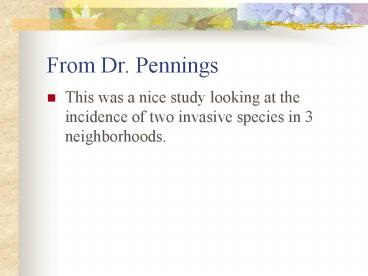From Dr. Pennings - PowerPoint PPT Presentation
1 / 26
Title: From Dr. Pennings
1
From Dr. Pennings
- This was a nice study looking at the incidence of
two invasive species in 3 neighborhoods.
2
Introduced and Invasive Weeds
- Biodiversity Project Fall 2006
3
Introduced and Invasive Weeds
- Cuscuta japonica Giant Asian Dodder
- Native to Asia (China, Korea, Japan)
- first Houston sighting in 2001 near Hobby airport
- Lysianthes asarifolia - South American Gingerleaf
- Native to S. America (Bolivia, Argentina,
Venezuala) - First Houston sighting approx. 1999 in Hunter
Creek Village
4
Purpose of Study
- Compare prevalence of species within three
Houston neighborhoods - Newer Homes constructed in 1970
- Older Homes constructed in 1920
- Adjacent Homes proximity to neighborhood with
Lysianthes identified by Texas Forest Service
(Hunter Creek Village) - Survey includes 685 homes
- www.zillow.com to find area information
5
Hypothesis
- A) Cuscuta is effectively controlled in Houston
by evidence of occurrence - B) Lysianthes will be more prevalent in specific
regions - Older homes will have a higher prevalence of
gingerleaf than new homes because mature trees
provide a shady environment. Also, planned
communities in new neighborhoods will have strict
deed requirements and more weed control in public
areas surrounding homes. - Homes located close to Hunter Creek Village will
have a higher number of incidents than new homes
because they have had more exposure to the weed.
6
Map of Hunters Creek Village, Piney Point, and
Hedwig Village
7
Cuscuta japonica Giant Asian Dodder
Devils vine, Strangleweed, Witchs hair
8
- Taxonomy
- Kingdom Plantae -- Plants
- Subkingdom Tracheobionta -- Vascular plants
- Superdivision Spermatophyta -- Seed
plants - Division Magnoliophyta -- Flowering
plants - Class Magnoliopsida -- Dicotyledons
- Subclass Asteridae
- Order Solanales
- Family Cuscutaceae -- Dodder
family - Genus Cuscuta L. -- dodder
- Species Cuscuta
japonica Choisy -- Japanese dodder - Distribution
- Greenhouses in California, South Carolina all
eradicated - Texas Forest Service has found four sites of
Cuscuta within Houston (2002 article date)
9
(No Transcript)
10
Characteristics
- Highly parasitic, lacks chlorophyll
- Can grow 6 inches per day
- Spreads through haustoria and seed production
- Threatens live oak and crape myrtle
- Seeds can survive for years
- Host species cannot be salvaged
- Soil must be sterilized for effective control
- May have been introduced and grown for medicinal
properties
11
(No Transcript)
12
South American Ginger Leaf Lycianthes asarifolia
13
- found in Memorial Park
- prefers wet, shady areas
- competitive with St. Augustine Grass
- reproduces vegetatively and sexually
- seeds are slow to germinate
14
- Taxonomy
- Kingdom Plantae -- Plants
- Subkingdom Tracheobionta -- Vascular plants
- Superdivision Spermatophyta -- Seed plants
- Division Magnoliophyta -- Flowering plants
- Class Magnoliopsida --
Dicotyledons - Subclass Asteridae
- Order Solanales
- Family Solanaceae -- Potato
family - Genus Lycianthes (Dunal)
Hassler -- lycianthes P - Species Lycianthes
asarifolia (Kunth Bouché) Bitter gingerleaf - Distribution
- Documented in City Park New Orleans, Lousiana
- First reported in Hunter Creek Village in 1999
- Several sweeps of herbicide have been ineffective
- May have spread through seeds or fruit
- Possibly spread through construction and/or lawn
service companies - Fruit is edible can be consumed raw, made into
candy (tablila), or into preserves
15
Found only in Harris County
16
Lycianthes - New Homes
- Jersey Village neighborhood
- Approx. 200 homes surveyed
- Built within last 30 years
- Located 30 miles from Hunter Creek Village (site
of first incidence) - Greatest occurrence of Lycianthes
17
Lycianthes Old homes
- Montrose/University of St. Thomas area
- Constructed in 1920
- Approx. 200 homes surveyed
- Less prevalence of Lycianthes
- One incident of Cuscuta
18
Cuscuta japonica - 1424 Kipling Dr
?Cuscuta
19
(No Transcript)
20
Lycianthes Adjacent Homes
- Piney Point Village and Hedwig Village
- Located close to Hunter Creek Village
- Similar to results from New Home data
21
Results for Lycianthes
- Old Homes had the fewest occurrence
- New Homes had highest occurrence
22
Conclusion
- Hypothesis a) Cuscuta
- Rejected one occurrence of Cuscuta beyond
Hobby airport - Hypothesis b) Lycianthes
- Rejected New homes had the highest occurrence,
followed by adjacent homes and older homes
23
Discussion
- Homes in Montrose/Univ. St. Thomas area, while
having mature trees, also had more landscaping
and less grass. This reduces possible
environments for growth of Lycianthes
24
- Construction may have led to spread of Lycianthes
in new neighborhoods. - Similarity of occurrence between adjacent
neighborhoods (Hedwig, Piney Point) and new
neighborhoods (Jersey Village) indicates that
invasion of Lycianthes may be widespread in
Houston - Most homes with Lycianthes had adjacent neighbors
who were also affected. - Higher incidence of Lycianthes may result in
increased herbicide usage, which is damaging to
the environment. - While eradication of Cuscuta in known areas has
been diligent, continual monitoring is crucial
25
Even a well-maintained lawn
can have this invasive weed
26
References
- USDA plant database http//plants.usda.gov/java/pr
ofile?symbolLYAS4 - Texas Invasives website http//www.texasinvasives.
org/Invasives_Database/Results/Detail.asp?SymbolC
UJA - TFS article - Lycianthes http//txforestservice.ta
mu.edu/shared/article.asp?DocumentID370mcurban - Cuscuta article http//www.invasive.org/eastern/ot
her/DicCusCjO01.pdf - Biology Department at Texas AM - Dodder
- http//www-aes.tamu.edu/mary/dodder/dodderMR.ppt
- http//dodder.tamu.edu/dist.asp
- Lycianthes article from Texas AM
- http//www-aes.tamu.edu/mary/Lastuff/La.htm































